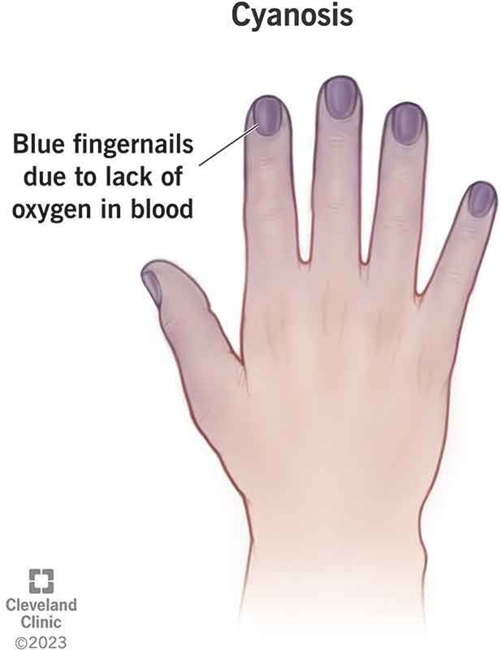The nurse notes that a client has cyanosis of the toes and fingertips. Which vital sign should the nurse obtain first?
Heart rate.
Blood pressure.
Temperature.
Respiratory rate.
The Correct Answer is D
Choice A reason: While heart rate is important, it is not the most immediate concern when a client shows signs of cyanosis.
Choice B reason: Blood pressure is a critical vital sign but does not directly address the issue of oxygenation, which is suggested by cyanosis.
Choice C reason: Temperature is less relevant to the immediate assessment of cyanosis, which is often related to oxygenation issues.
Choice D reason: Respiratory rate should be assessed first as cyanosis is a sign of potential hypoxia, and the respiratory rate can provide immediate information about the client's breathing and oxygenation status.

Nursing Test Bank
Naxlex Comprehensive Predictor Exams
Related Questions
Correct Answer is B
Explanation
Choice A reason: While teaching alternative ways to manage pain is important, it does not address the immediate issue of the client not taking the medication as prescribed.
Choice B reason: The client should be instructed to take the medication as prescribed to maintain consistent pain control and prevent breakthrough pain.
Choice C reason: Advising the client to take the medication only with severe pain is contrary to the prescribed regimen and could lead to inadequate pain management.
Choice D reason: It is important to discuss the risks of long-term medication use, but the priority is to ensure that the client understands the importance of taking the medication as prescribed for effective pain management.
Correct Answer is ["2"]
Explanation
The healthcare provider has prescribed 4,800 mg of magnesium hydroxide. The bottle indicates that each 5 mL contains 400 mg of magnesium hydroxide. We also know that 1 ounce (oz) is equivalent to 30 mL.
Step 1: The amount of magnesium hydroxide the patient needs is 4,800 mg.
Step 2: The concentration of the magnesium hydroxide solution is 400 mg per 5 mL. Step 3: Substitute the values into the formula: 4,800 mg ÷ (400 mg/5 mL).
Step 4: Calculate the volume in mL: 4,800 ÷ (400/5) = 60 mL.
Now, we need to convert this volume from mL to ounces.
Step 5: We know that 1 oz = 30 mL.
Step 6: Substitute the values into the formula: 60 mL ÷ 30 mL/oz.
Step 7: Calculate the volume in oz: 60 ÷ 30 = 2 oz.
Whether you are a student looking to ace your exams or a practicing nurse seeking to enhance your expertise , our nursing education contents will empower you with the confidence and competence to make a difference in the lives of patients and become a respected leader in the healthcare field.
Visit Naxlex, invest in your future and unlock endless possibilities with our unparalleled nursing education contents today
Report Wrong Answer on the Current Question
Do you disagree with the answer? If yes, what is your expected answer? Explain.
Kindly be descriptive with the issue you are facing.
